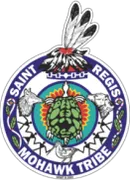Danny Jacobs and Tribe’s Environment Division Collaboration Credited
Late fall along the St. Lawrence River is easily recognized by dropping water temperatures, shoreline ice and the first snow fall giving way to winter. Bitter cold winters are iconic of the St. Lawrence River Valley, and an important factor for production of high quality pelts of aquatic fur bearing animals such as the otter, mink, beaver and muskrat.
As the season changes colder, the ‘skin’ of fur bearing animals adapts with thicker insulated skin and thicker waterproofed body fur to tolerate cold temperature water exposures. The animal pelt’s value, for quality and market trade, is directly linked to these physiological adaptations that increase the likelihood of over-wintering survival in the natural environment. A “Top Lot Award” by the Fur Harvesters Auction (FHA), Inc. rewards both the animal’s health and fitness indicated in its leather and the fur-handlers meticulous skill.
Fur bearing animals adaptation to survive the treacherous winter environment made the trapping and trade of these animals valuable and respected as clothes and shelter. Some furbearers have additional value as food and/or medicine. Today, aquatic furbearers still offer a pathway for Indigenous cultural connectivity, shared traditional teachings and the reminder of the sacred trust, duty, respect and responsibilities between humans, animals and the natural world for balance.
The populations of these animals have been affected in different ways (i.e. overharvesting, habitat alteration, environmental pollution, etc.), over different periods of time. The SRMT Environment Division received funding in 2010 from the U.S. EPA Great Lakes Restoration Initiative (GLRI) for a two-year study to assess if any potential impact exists still to populations and reproductive health of otter, mink, beaver and muskrat due to industrial contamination (i.e. PCBs, pesticides, mercury and dioxins) in the St. Lawrence River Area of Concern (AOC).
Year-One Field Study was initiated in October 2011 and looked at internal health indicators, external abnormalities, health of the body fat, reproductive health and tested for any contaminants in muscle or liver tissue. To conduct this full body health assessment, fur-on whole body samples were needed of otter and beaver. To help obtain samples of the elusive otter, SRMT Environment Division Wildlife Technician Jay Wilkins combined efforts with Akwesasne community member, trapper and sturgeon fisherman Danny Jacobs, after a chance meeting on the river while both were setting traps. A collaborative relationship developed out of mutual respect of trapping and cultural practice preservation desire.
Danny was proactive in communicating with Jay when he would catch an otter or mink to assist SRMT field study efforts. For quality assurance purposes of the study, Jay would retrieve the otter, handle the fur and return the pelt to Danny as a finished product, while obtaining the necessary scientific data needed on the individual animal health. In late fall 2011, three of the otter pelts were sent by Danny to the FHA. One of the pelts was recognized out of the approximately 4,000 otter pelts sent to auction that same year to receive the 2012 Otter “Top Lot Award” by the FHA.
“This is a major achievement as only the best quality, best color, prime, well-handled skins make this grade,” according to FHA’s CEO Mark Downey letter of award.
“The Top Lot award was a reminder of this remarkable collaborative effort that developed in the field utilizing Mohawk traditional ecological knowledge (TEK) to locate the target species, utilization of science for assessing animal health and populations, SRMT Wildlife Technician skill and expertise at handling fur and a common goal to fulfill our duty to the natural world, to preserve and protect it,” said SRMT’s St. Lawrence River AOC Program Manager, Jessica Jock.
The otter is traditionally known as the leader of the water world. The presence of a high quality, healthy otter in the St. Lawrence River is an example of a positive indicator of current environment health. Beaver and muskrat have traditionally been consumed and play a role in creating and maintaining high quality wetland habitat and food web connectivity, and mink populations are sensitive to PCBs. Each target species has a cultural and natural world duty, and each tells us something a little different about our environment or human health exposures to toxins in the environment.
SRMT Environment Division initiated its Year Two-Furbearer Mammal Study to replicate field sampling efforts. If any Mohawk trapper is interested in receiving health information or PCB data on the beaver and muskrat they consume, or mink and otter they are trapping, please contact SRMT Environment Division 518-358-5937 and leave a message with the receptionist for Jay Wilkins, SRMT Wildlife Technician. All data results and study conclusions will be available to the public in 2014, after completion of October-December 2013 field study and data review.
# # # #
Photos:
SRMT Wildlife Technician Jay Wilkins (left), and Akwesashró:non Danny Jacobs (right) displaying the 2012 FHA Otter “Top Lot Award”.


# # # #
For more information contact the Communications Department at 518-358-2272.

